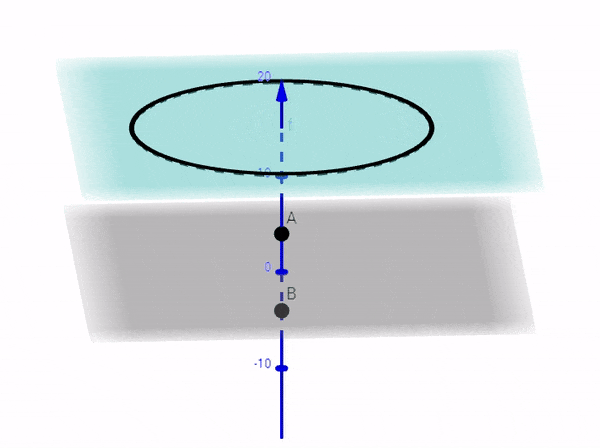I will give you the mathematical details at the last, first just visualize what is going on. I am assuming that slits are like pinholes because if you took into account that they are thin rectangles then fringes won't be exactly hyperbolic and it will be mixed problem of interference and diffraction.
In all the diagrams and animations, blue axis is Z, red is X and green is Y.
This is how a fringe looks on a screen (Pink) perpendicular to the y-axis(green) when two slits A and B are placed along the z-axis(Blue).

Now a lot of people explain this by saying that:
"A fringe is obtained when path difference of interfering waves is constant. So, the locus of that point from which the difference between the distances from A and B to that point is constant is a Hyperbola. Hence, the fringes are Hyperbolic." This is true if we are looking, for the locus of those points, on a plane which passes through A & B. As the gif below shows different planes passing through A and B contain those hyperbolas:

But, that's not true, in general, if you are looking for the points in a plane which doesn't pass through points A and B. For example, if you look for fringes in a plane that is perpendicular to the line joining A and B, then the fringes will be CIRCULAR.

Because, it is true that for each plane passing through A and B locus of those points is a hyperbola, and whole 3D space can be thought as made up of infinite planes passing through points A & B, the locus in 3D space will be all those hyperbolas combined to form a hyperboloid; as shown below:

Now if we want to find locus on any plane we can just take the intersection of this hyperboloid with the plane.
Mathematical Details:
I will first prove that the locus is hyperboloid and then will take the intersections to find fringe shapes on desired planes.
Let A be $(0,0,a)$ and B be $(0,0,-a)$. Coordinates are in the order (x,y,z). Locus of points which have a constant path difference is:
$\sqrt{(z+a)^2+(x^2)+(y^2)}-\sqrt{(z-a)^2+(x^2)+(y^2)} = d $
$\sqrt{(z+a)^2+(x^2)+(y^2)} =\sqrt{(z-a)^2+(x^2)+(y^2)} + d $
Squaring both sides:
${(z+a)^2+(x^2)+(y^2)} ={(z-a)^2+(x^2)+(y^2)} + 2\sqrt{(z-a)^2+(x^2)+(y^2)}d + d^2 $
$4za = 2\sqrt{(z-a)^2+(x^2)+(y^2)}d + d^2$
$(2za - \frac{d^2}{2})^2 = ((z-a)^2+(x^2)+(y^2)) d^2 $
Re-arrange to get:
$z^2 - \frac{x^2 + y^2}{\frac{4a^2}{d^2} -1} = \frac{d^2}{4}$
Let $\frac{4a^2}{d^2} -1=k^2$
So you get: $z^2 - \frac{x^2 + y^2}{k^2} = \frac{d^2}{4}$
Now, $x^2 + y^2 = {\rho}^2$
,where $\rho$ is the distance of any point from z-axis or if you know cylindrical coordinates, it is the cylindrical radius.
Our equation now becomes:
$z^2 - \frac{{\rho}^2}{k^2} = \frac{d^2}{4}$
So, it is a hyperboloid.
If the screen is perpendicular to y-axis(green axis), the equation of the plane would be $y = h$. Substitute $y=h$ in the equation of hyperboloid, you will get an equation of hyperbola (in x and z):
$z^2 - \frac{x^2}{k^2} = \frac{d^2}{4} - \frac{h^2}{k^2} $
It is shown below as as the black curve of intersection:

If the screen is perpendicular to line joining A and B (or perpendicular to z-axis) then substitute $z = h$ in the equation of the hyperboloid and you will get a circle in x and y, giving you the circular fringes $x^2 + y^2 = (h^2 - \frac{d^2}{4})k^2$ as shown below as the black curve of intersection:







